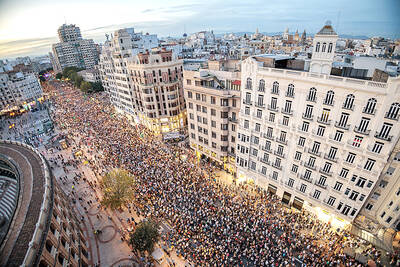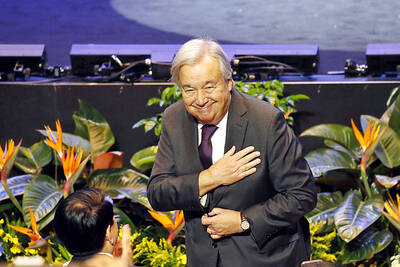A battle has broken out between conservationists over attempts to save the orangutan. The groups are divided over the issue of reintroducing to the wild orphaned animals that are now living in refuges in Borneo and Sumatra.
On one side, experts say such attempts can no longer be considered important and that all efforts must be directed to saving the apes’ last rainforest homes.
“If we cannot protect animals in the wild, there is no point in reintroducing rescued apes to rainforests,” said Ashley Leiman, of the Orangutan Foundation.
But this view is disputed by campaigners who say refuges are today bursting with almost 1,000 orangutans.
“It is a simple matter of welfare,” Cambridge biologist David Chivers said.
“We are keeping these animals in artificial environments, in enclosures. Their rehabilitation should not be sneered at,” Chivers said.
The issue will form the core of the Great Ape Debate to be held at the Linnean Society in London on Thursday when conservationists will argue over the growing controversy surrounding measures to save the orangutan.
At stake is the survival of one of humanity’s closest evolutionary cousins, a creature whose numbers are plummeting alarmingly. In Sumatra there are only 7,000 of the species, Pongo abelii, which is now “critically endangered,” while in Borneo, there are 40,000 members of the Pongo pygmaeus species. Its status is “endangered.”
All great apes — chimpanzees, gorillas and orangutans — are suffering from dramatic declines in numbers. Chimps and gorillas are victims of several forms of human activity, including their hunting for bushmeat. However, the orang-utan is affected by a single threat: habitat loss.
Across Borneo and Sumatra, swaths of rainforest are being chopped down for wood and to provide land for farmers wishing to plant oil palm and acacia trees. More than 1 percent of the forest is destroyed every year.
For orangutans, the impact is devastating. Driven from their rainforests, adults are often shot by loggers or farmers when they stray into fields.
Young orangutans are often caught by villagers and taken to a refuge.
Conservationists estimate that there are at least 800 orangutans, most of them young, living in refuges in Borneo and Sumatra. Mary Tibbett, of the World Land Trust, said her group was committed to protecting orangutan communities and was attempting to buy up land around the Kinabatangan Wildlife Sanctuary in Borneo to provide homes for them.
“Reintroductions sound fine but carry risks of bringing in diseases that orangutans have picked up from humans or letting loose animals who simply do not have the skills to look after themselves in the wild,” she said.
But Chivers said that, in the long term, keeping orphaned animals in refuges could harm wild populations.
“Keeping hundreds of animals in refuges separated from wild animals means you are isolating a large chunk of the orangutan gene pool. That is ultimately harmful to the species. We need to reintroduce these animals,” he said.

DOUBLE-MURDER CASE: The officer told the dispatcher he would check the locations of the callers, but instead headed to a pizzeria, remaining there for about an hour A New Jersey officer has been charged with misconduct after prosecutors said he did not quickly respond to and properly investigate reports of a shooting that turned out to be a double murder, instead allegedly stopping at an ATM and pizzeria. Franklin Township Police Sergeant Kevin Bollaro was the on-duty officer on the evening of Aug. 1, when police received 911 calls reporting gunshots and screaming in Pittstown, about 96km from Manhattan in central New Jersey, Hunterdon County Prosecutor Renee Robeson’s office said. However, rather than responding immediately, prosecutors said GPS data and surveillance video showed Bollaro drove about 3km

‘MOTHER’ OF THAILAND: In her glamorous heyday in the 1960s, former Thai queen Sirikit mingled with US presidents and superstars such as Elvis Presley The year-long funeral ceremony of former Thai queen Sirikit started yesterday, with grieving royalists set to salute the procession bringing her body to lie in state at Bangkok’s Grand Palace. Members of the royal family are venerated in Thailand, treated by many as semi-divine figures, and lavished with glowing media coverage and gold-adorned portraits hanging in public spaces and private homes nationwide. Sirikit, the mother of Thai King Vajiralongkorn and widow of the nation’s longest-reigning monarch, died late on Friday at the age of 93. Black-and-white tributes to the royal matriarch are being beamed onto towering digital advertizing billboards, on

Tens of thousands of people on Saturday took to the streets of Spain’s eastern city of Valencia to mark the first anniversary of floods that killed 229 people and to denounce the handling of the disaster. Demonstrators, many carrying photos of the victims, called on regional government head Carlos Mazon to resign over what they said was the slow response to one of Europe’s deadliest natural disasters in decades. “People are still really angry,” said Rosa Cerros, a 42-year-old government worker who took part with her husband and two young daughters. “Why weren’t people evacuated? Its incomprehensible,” she said. Mazon’s

POWER ABUSE WORRY: Some people warned that the broad language of the treaty could lead to overreach by authorities and enable the repression of government critics Countries signed their first UN treaty targeting cybercrime in Hanoi yesterday, despite opposition from an unlikely band of tech companies and rights groups warning of expanded state surveillance. The new global legal framework aims to bolster international cooperation to fight digital crimes, from child pornography to transnational cyberscams and money laundering. More than 60 countries signed the declaration, which means it would go into force once ratified by those states. UN Secretary-General Antonio Guterres described the signing as an “important milestone,” and that it was “only the beginning.” “Every day, sophisticated scams destroy families, steal migrants and drain billions of dollars from our economy...